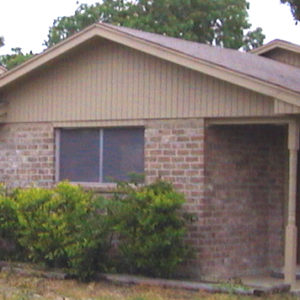I have an almost 40 year old house with a corner kitchen. The kitchen has cathedral ceiling rooms on both sides of it and there is no access to the attic area above the kitchen. The kitchen is easily the warmest room in the house in summertime due to poor insulation judging by other rooms with ceiling access where the fiber glass is currently only 3 to 4″ deep. My Intention is to put R30 fiberglass over the existing insulation to help cool the room off and lower my energy bills which are ridiculous.
The question is whether I should cut an access port in the kitchen ceiling or in the exterior of the gable end panel which is one of it’s walls. Both are possible and each has it’s own pro’s & con’s.
The external approach would be the easiest to conceal by framing the opening with a louvered gable vent on the way out and or by replacing the plywood gable panel with Hardi Panel (which I intend to do anyhow), it also gives one the most natural light to lay down the insulation. See Pic of kitchen exterior for clarification.
The inside would have the easiest access and least hassle of loading insulation into the space, but would be a more time consuming approach to patch back together and would cause the most mess (sanding the 3 coats of dried mud).
Which way would you go & why?
Ken





















Replies
I'd go from outside.
Who wants drywall dust and fiberglass or whichever insulation fibers in the kitchen? And it should actually be easier to work from outside.
Mark,
Thanks for the reply.
That's what I'm thinking too, I just wanted to see if there was something I wasn't thinking about.
Ken
I go for the outside access and just use blown in cellulose. You could probably shoot most of it from outside anyway judging on the house size
Either work from the outside or figure out a way to conceal the access in the kitchen ceiling (eg, with a gridwook).
Cellulose is the no brainer for this one
Is that gable the kitchen area?
You can blow it in there a foot or more deep in 10 minutes & be done with it.
No need to crawl around in the itchy FG.
See if your local big box has a loaner if you buy it from them, or rental yard.
Much better insulation than FG & it'll go right over the old stuff.
Joe H
Yes, the gable is over the kitchen in that corner.
I'm more than convinced that coming from the outside is the way to go. Haven't had an "inny" yet.
Reading reveiws of folks who went the cellulose route, they all were boffo for it. However, all the reviews I read for the folks who used Owing Corning's ATTICAT expanding FG were also all boffo too. No dust, no itching, OK to work in T shirt, no respirator, what's not to like? There's no question that cellulose is cheaper and you can get to the same R values by pumping it in, but it's definitely heavier, isn't it?
Why do you feel it's better & a no brainer? I may have missed something about cellulose along the way.
Ken
My mistake
I assumed (bad word) you were going to add another layer of FG batts.
Cells or blown in FG, I don't know how they compare.
The big boxes must be making more money on it cuz they dumped all their cell machines for FG blowers.
Joe H
Joe,
The HD store in my area carries both (cell & FG) machines and products.
Ken
Cellulose is pretty clean too. No itching, you can work in your swim suit if you want, though you should wear a simple dust mask while blowing it.
Consider a radiant barrier and some ventilation...
Since your issue is heat in the summer.... . To accomplish your goal not only do you want to block heat from the attic from getting into the house but you want to reduce summertime attic temperatures. A tin foil radiant barrier could be stapled up to the underside of the rafters. This helps to reduce attic temperatures by blocking/reflecting the sun's energy. If you do a Google search you will find that the U of FLA and another U in Texas has done a lot of research and concluded that radiant barriers are money well spent for hot climates.
Also, what about attic ventilation? Is there any? If not I'd start by installing a ridge vent to let some heat out the top. Looking at your pic that would be a relatively easy and not too expensive of a job. You may need to do some research to find out what type of ridge vent is the most storm resistant, based on your Corpus Christi location. You mentioned a gable end vent, but really, based on current thinking, these are for aesthetics rather than functionality. Along the line of aesthetics, I'm not so sure a gable end vent would go with the style of your house anyway unless it was the large triangular type that fills the entire top portion of the gable. I would stay away from as this would as it allows for the possibility of wind driven rain to enter your attic. That could spell disaster, especially if you put cellulose insulation up there. When you blow insulation up there, you need to be sure you don't block the soffit vents - if there are some - there should be...
Prior to adding insulation, when you are up there the first thing to do is hunt down holes between the attic and the living space and plug them. This could even be started from the interior by taking down the kitchen light fixture and plugging whatever hole is almost inevitable there based the vintage construction that you have. Air flow is your worst enemy.
As far as the Q about the type of insulation one thing that is bad about fiberglass is that as the outside temperature falls well below freezing fiberglass tends to loose it’s insulative qualities. This doesn’t occur with cellulose, but this doesn’t pertain to your situation based on your local climate. The other thing undeniably superior about cellulose is that it blocks air flow better than fiberglass. The bad thing about cells is that it can absorb moisture and become very heavy. So, re cells, for your situation, you have 1 minus and one plus, which is similar to what you will have with fiberglass, so I don’t see cells as a clear choice for your climate. Further, I’m not sure if applying cells over fiberglass is a good thing. An insulation contractor told me that this can result in moisture buildup right at the interface between the old fiberglass and the new cells as moisture from the interior migrates up and tries to escape. I don’t know this for a fact – just relating what a qualified person told me… I posed this question on a few forums, but didn’t really get any answers, just a bunch of tangents – like this post :-)
Re the attic access, it does look like exterior would be easier. Looking at the type of siding you have it would seem that you could cut an access and then somehow make a panel that would be able to removed again at a later date if necessary. BTW – it looks like you have that type of siding elsewhere on your home. Is it T-111 plywood? I was thinking you could go to board and batten with Hardi panel but I’m not sure how this would go with the style of your house and it may be totally un-necessary and more than you bargained for… A pic of the house from further back might help to answer this Q…
Matt, Thanks for the
Matt,
Thanks for the thoughtful reply.
There is currently attic ventilation in the form of soffit vents on the overhangs and I had a Sola Tube brand solar attic fan added to that roof over the kitchen on the back slope. That fan is rated to vent an area 3 times the size of the kitchen. There are also static roof vents on the back slope as well.
I had not really considered cellulose because of the load if it gets wet and that is always a possibilty in an area that has seen a few hurricanes before. I hadn't heard about the possibility of moisture forming at the FG-Cell boundary.
As far as radiant barrier goes, I intend to re-roof the house in the next year and had already made the decision to replace the decking with LP Techshield OSB with an aluminum radiant barrier on one side. Their measured tests show that a reduction in temperature of close to 30 degrees is achievable in the attic space. On the other hand, applying some foil to the inside now would lower this years cooling costs and would also keep the vent space clear of blown in FG.
Yes, the siding is T-111 and the entire south facing back wall is covered with it as are the gable panels. The plan is to clean & paint the brick white and replace all the T-111 with Rigid foam insulation, Hardi Weather barrier, and Hardi panel with the stucco face appearance which will get the same color paint as the brick. I realize that Hardi recomends use of battens with it's panels but I'm going to see if I can make the seams less noticable with a good elastomeric caulk job.
I'm aware that sealing air penetrations is a big step in the right direction and intend to do that as prep work. Mike Guertin wrote a great article about it, which can be found in the HOW TO section.
Thanks,
ken
LP TecShield
I'm a big fan of it. I have it on my own house and have installed it on several new construction homes. It would seem that it would be cost prevntative on remodel situations, but maybe not in your case. Doing the staple up stuff would be difficult on that low slope roof you have.
Blown FG same as batts??
fiberglass is that as the outside temperature falls well below freezing fiberglass tends to loose it’s insulative qualities
Same effect for the blown in?
Joe H
Yes
To my knowledge. I would suspect that blown is even worse as it is not a dense.
Guess not in Texas
Probably not be a concern to the OP, The power of advertising, an expensive product that isn't worth a damn sold everywhere. Joe H